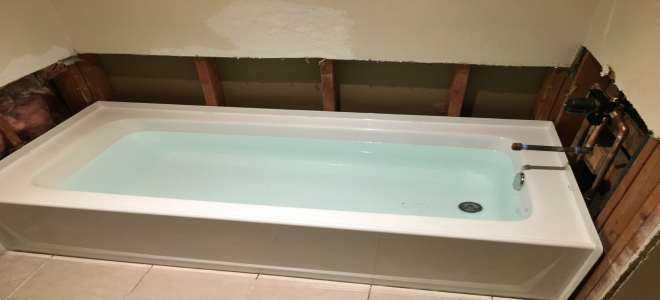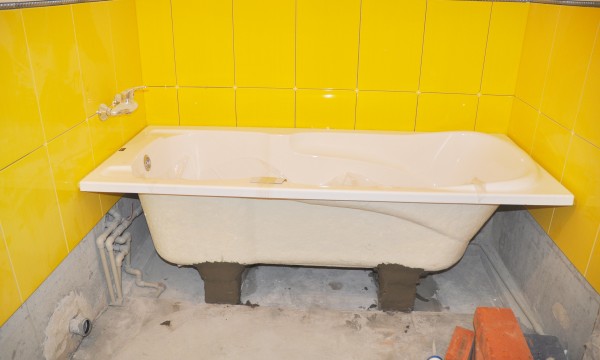How to Remove and also Replace a Bath Tub.
How to Remove and also Replace a Bath Tub.
Blog Article
We have found this article pertaining to How to Install a Bathtub down the page on the internet and think it made sense to talk about it with you over here.

Mounting a bathtub isn't specifically brain surgery, however it does require strong plumbing, carpentry, as well as sometimes, tiling abilities. Replacing an old tub with a new one is likewise a moderately tough project. If the old tub is easily obtainable, the job can relocate quickly; if you need to open a wall surface to remove the old bathtub and also position the brand-new bathtub, the task is much harder. In either instance, the project is within a residence handyman's skills, although you will require a helper to leave the old bathtub as well as embeded in the new one. Ensure you have actually qualified on your own for the job as well as fit attempting it. Instead of working with a professional to take control of a halfway-completed task, it is better to think about using one before you start. Chances are you may require a professional plumber to make tube connections.
This post will certainly help you set up a brand-new bath tub in your bathroom if you have currently acquired a brand-new bathtub and don't need to transform the setup of your previous supply of water pipes.
Your devices and also product checklist ought to make up the following:
Removing Old Taps
If you need to replace old taps with new ones as a part of your setup, after that the first thing you should do is detach the water system. After doing so, activate the faucets to drain pipes any kind of water remaining in the system. The process of removing the existing taps can be fairly bothersome as a result of the limited access that is typically the instance.
Use a basin wrench (crowsfoot spanner) or a tap tool to undo the nut that links the supply pipelines to the faucets. Have a towel all set for the staying water that will originate from the pipes. When the supply pipelines have been eliminated, utilize the exact same device to loosen the nut that holds the taps onto the bath/basin. You will need to stop the single faucets from transforming throughout this procedure. As soon as the faucets have actually been eliminated, the holes in the bath/basin will certainly have to be cleaned up of any type of old sealing compound.
Prior to carrying on to fit the new taps, compare the pipe links on the old faucets to the brand-new faucets. If the old taps are longer than the brand-new faucets, after that a shank adapter is needed for the new taps to fit.
Fitting New Touches
If the tails of the brand-new faucets are plastic, after that you will need a plastic connector to stop damages to the thread. One end of the connector fits on the plastic tail of the faucet and also the other end gives a link to the existing supply pipes.
If you need to fit a monobloc, after that you will certainly need decreasing couplers, which connects the 10mm pipeline of the monobloc to the conventional 15mm supply pipe.
Next off, place the tap in the mounting opening in the bath/basin making certain that the washers are in area in between the tap and the sink. Safeguard the faucet in place with the manufacturer given backnut. When the faucet is safely in place, the supply pipelines can be linked to the tails of the taps. The faucets can either be linked by using corrugated copper piping or with regular faucet connectors. The previous type needs to be linked to the tap finishes first, tightening just by hand. The supply pipes can later on be linked to the other end. Tighten up both ends with a spanner after both ends have been attached.
Setting up the Bathtub
Making use of the two wood boards under its feet, place the bath tub in the needed placement. The wood boards are helpful in equally spreading the weight of the bath tub over the area of the boards instead of focusing all the weight onto 4 tiny points.
The next objective is to make sure that the bathtub is leveled all round. This can be accomplished by checking the level and readjusting the feet on the bathtub until the level reads degree.
To install taps, fit all-time low of the furthest adaptable tap adapter to the appropriate supply pipeline by making a compression join; then do the very same for the other faucet.
Turn on the water supply and examine all joints and brand-new pipework for leakages and tighten them if essential. Fill the tub as well as likewise examine the overflow outlet as well as the regular outlet for leakages.
Lastly, deal with the bath paneling as explained in the supplier's instruction manual. Tiling as well as securing around the bathtub must wait till the bathtub has been made use of at least once as this will certainly resolve it into its final placement.
Preparing for the Installation
First of all, the sustaining structure supplied with the bath must be fitted (if called for) according to the manufacturer's directions. Next off, fit the taps or mixer to the tub. When suitable the faucet block, it is essential to ensure that if the tap features a plastic washing machine, it is fitted between the bath and the taps. On a plastic bath, it is likewise reasonable to fit a sustaining plate under the taps unit to avoid stress on the tub.
Fit the adaptable faucet adapters to the bottom of the two taps using 2 nuts as well as olives (often provided with the bathtub). Fit the plug-hole outlet by smearing mastic filler round the sink outlet hole, and after that pass the electrical outlet via the hole in the bathroom. Make use of the nut provided by the maker to fit the plug-hole. Check out the plug-hole electrical outlet for an inlet on the side for the overflow pipeline.
Next off, fit completion of the adaptable overflow pipeline to the overflow electrical outlet. Afterwards, screw the pipeline to the overflow face which need to be fitted inside the bathroom. Make sure you use all of the supplied washing machines.
Attach the catch to the bottom of the waste electrical outlet on the bath tub by winding the string of the waste electrical outlet with silicone mastic or PTFE tape, as well as screw on the trap to the outlet. Connect the bottom of the overflow tube in a similar manner.The bathroom need to now be ready to be fitted in its final position.
Tiling Around the Bath tub
In the location where the bathroom satisfies the ceramic tile, it is needed to seal the joins with a silicone rubber caulking. This is essential as the installation can relocate sufficient to split a stiff seal, triggering the water to penetrate the wall in between the bathroom as well as the tiling, leading to difficulties with wetness as well as possible leaks to the ceiling listed below.
You can pick from a variety of coloured sealers to assimilate your fixtures and installations. They are marketed in tubes as well as cartridges, as well as are capable of securing spaces as much as a width of 3mm (1/8 inch). If you have a bigger space to fill up, you can fill it with spins of drenched newspaper or soft rope. Keep in mind to always fill the bath tub with water before sealing, to permit the motion experienced when the bathtub is in use. The sealer can split fairly very early if you do not think about this movement prior to sealing.
Alternatively, ceramic coving or quadrant floor tiles can be utilized to edge the bathroom or shower tray. Plastic strips of coving, which are easy to use and reduce to dimension, are also conveniently offered on the market. It is suggested to fit the ceramic tiles using water-resistant or water-proof sticky and cement.
Bathtub Installation
How Important Is A Bathtub To Your Home?
High-quality baths, showers, and other bathroom updates are necessary when considering a smart investment in your home. It’s a room that you go to every day and one that is constantly being used by guests.The bathroom is one of the top trafficked rooms in a home and also one of the most valuable in terms of home resale.
Install Piping Before Tub
You will be using your existing drain and waste vent system, but pipes required include the hot and cold water supply lines and a pipe leading to a shower head. A mixing valve and shower head are also needed. Air chambers may be required.
Position the Tub
Lower the tub into place so that the continuous flange fits against the wall studs and rests on 1’x4' or 2’x4' supports. Anchor the tub to the enclosure with nails or screws inserted through the flanges into the studs.
NOTE: Remember, bathtubs and shower stalls may require support framing. A bathtub filled with water is extremely heavy, so check building codes and framing support before installing the tub.
Assemble Drain Connections
Assemble the bathtub drain connections by connecting the tub overflow with the tub drain above the trap, not beyond it. The trap will have a compression fitting that screws over the arm of the overflow assembly.
Place a Pipe For the Shower Head
First, locate a brass female threaded winged fitting and attach it to a framing support via a screw or a nail. Then run a pipe up the wall for the shower head. Sweat or solder the other side of the brass fitting to the top of the pipe.
Attaching Hot and Cold Water Lines
Attach your water lines for both hot and cold by sweating these directly into the hot and cold ports of the mixing valve. The mixing valve will be how water enters the tub’s system, not by the pipes themselves.
Install the Spout
Extend a piece of 1/2 inch pipe, or whichever length is specified in the manufacturer’s instructions, for the tub spout. Sweat on a male threaded fitting at the end of the pipe or use a brass nipple of the proper length and a 1/2 inch cap.
NOTE: At this point you should have your rough-in plumbing work inspected before proceeding further.
Check For Leaks
Restore the water pressure and check the drain connection and the supply pipes for any sign of leaking.
estore the Bathroom Wall
Replace the wall with moisture-resistant drywall as a base for your wall covering. Seal the joints between the wall and your new tub with silicone caulk as protection against water seepage.
https://www.berkeys.com/2016/12/02/bathtub-installation-dallas/

I am just very taken with How to Install a Bathtub Yourself and I'm hoping you liked the new article. Are you aware of another individual who is interested in the niche? Do not hesitate to share it. Thanks for your time. Don't forget to check up our site back soon.
Book Maintenance Report this page